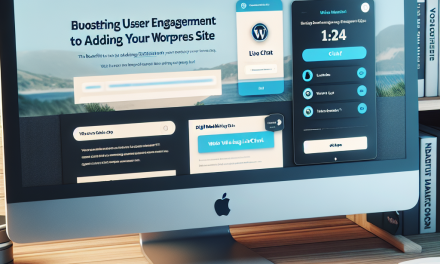As a website owner in today’s digital landscape, ensuring compliance with the General Data Protection Regulation (GDPR) is not just a legal obligation, but also a best practice to gain and retain user trust. If you’re running a WordPress site, you’re in luck! WordPress offers several tools and plugins to help you configure your site for GDPR compliance. In this article, we’ll walk you through the essential steps to take to ensure your website aligns with GDPR requirements.
1. Understand What GDPR Is
Before diving into the technicalities of compliance, it’s critical to understand what GDPR entails. The GDPR is a regulation in EU law that emphasizes data protection and privacy for individuals within the European Union and the European Economic Area. It governs how businesses collect, store, and process personal data. Familiarizing yourself with GDPR can help you identify areas of your WordPress site that may need adjustment.
2. Update Your Privacy Policy
One of the fundamental requirements of GDPR is having a clear and transparent privacy policy. This policy must explain how your site collects, uses, and protects personal information. Be sure to include:
- What types of data you collect (e.g., names, emails, IP addresses)
- How you collect user data (e.g., contact forms, cookies)
- Why you collect this data
- How users can exercise their rights to access or delete their data
You can easily add a privacy policy to your WordPress site using the built-in privacy settings available in the Settings > Privacy section of your dashboard.
3. Use GDPR Compliance Plugins
WordPress offers various plugins designed to help you ensure GDPR compliance. Some popular options include:
- WP GDPR Compliance: This plugin helps you add checkboxes to forms and manage user consent.
- Cookie Notice & Compliance for GDPR / CCPA: Useful for informing visitors about cookie usage and obtaining consent.
- GDPR Cookie Consent: A plugin that adds a cookie banner to your site to inform users about tracking cookies.
Be sure to check out the WordPress Plugin Directory for more options and user reviews.
4. Implement a Cookie Management System
Cookies are a big part of web browsing, but they also pose privacy risks. GDPR requires that users are informed about cookies when they visit your site, allowing them to provide explicit consent. Utilize a cookie consent plugin to create a banner that complies with GDPR guidelines. This banner should outline the types of cookies you use and give visitors the option to accept or decline.
5. Protect User Data
Ensure that your WordPress site is secure to protect the personal data of your users. Follow these best practices:
- Use SSL Encryption: Ensure your site is HTTPS enabled. This encrypts data transferred between the user’s browser and your server.
- Regular Backups: Use tools like UpdraftPlus or BackupBuddy to regularly back up your website.
- Update WordPress and Plugins: Keeping your WordPress core and plugins updated helps eliminate vulnerabilities.
6. Enable User Rights
Under GDPR, users have the right to access, amend, or delete their data. Make it easy for users to exercise these rights on your WordPress site:
- Implement forms or automated processes where users can request their data or deletion.
- Use plugins like WP Data Access or GDPR & CCPA Compliance Manager that facilitate data exports and deletion requests.
7. User Registration and Consent
If your WordPress site has user registration features (such as for comments, memberships, or subscriptions), ensure that you obtain explicit consent during the registration process. You can customize registration forms to include consent checkboxes for users to agree to your privacy policy and terms of service.
8. Regularly Review and Audit
Compliance with GDPR isn’t a one-time job. Regularly review your policies, data practices, and plugins to ensure ongoing compliance. Keep updated with any changes in the law and adapt your WordPress site as necessary.
Conclusion
Configuring your WordPress site for GDPR compliance is essential in protecting your users’ data and maintaining their trust. By following these essential steps, you can ensure your site aligns with GDPR regulations and provides a transparent experience for your visitors.
For those looking for a feature-rich, secure, and scalable WordPress environment, consider WafaTech NextGen WordPress Hosting. With advanced security, automated backups, and expert support, we help you focus on creating while we handle the technical intricacies. Learn more about WafaTech NextGen WordPress Hosting and take your WordPress site to the next level today!
For more tools and plugins, remember to explore the official WordPress site for comprehensive resources and updates.





